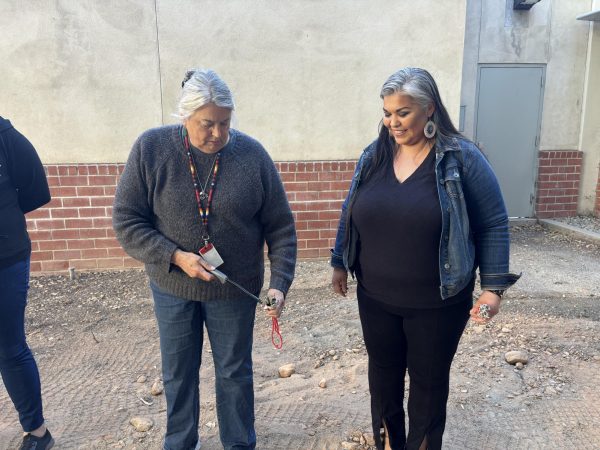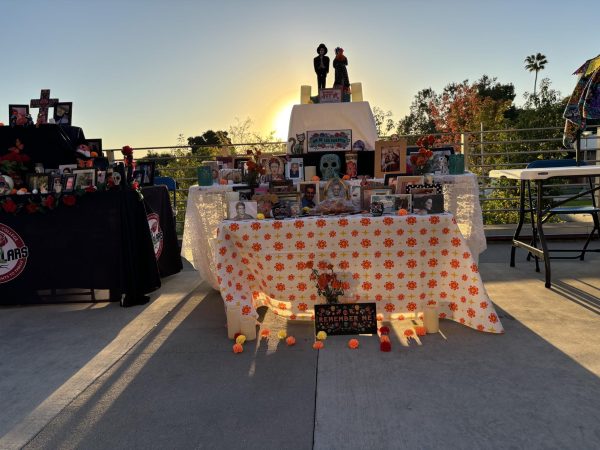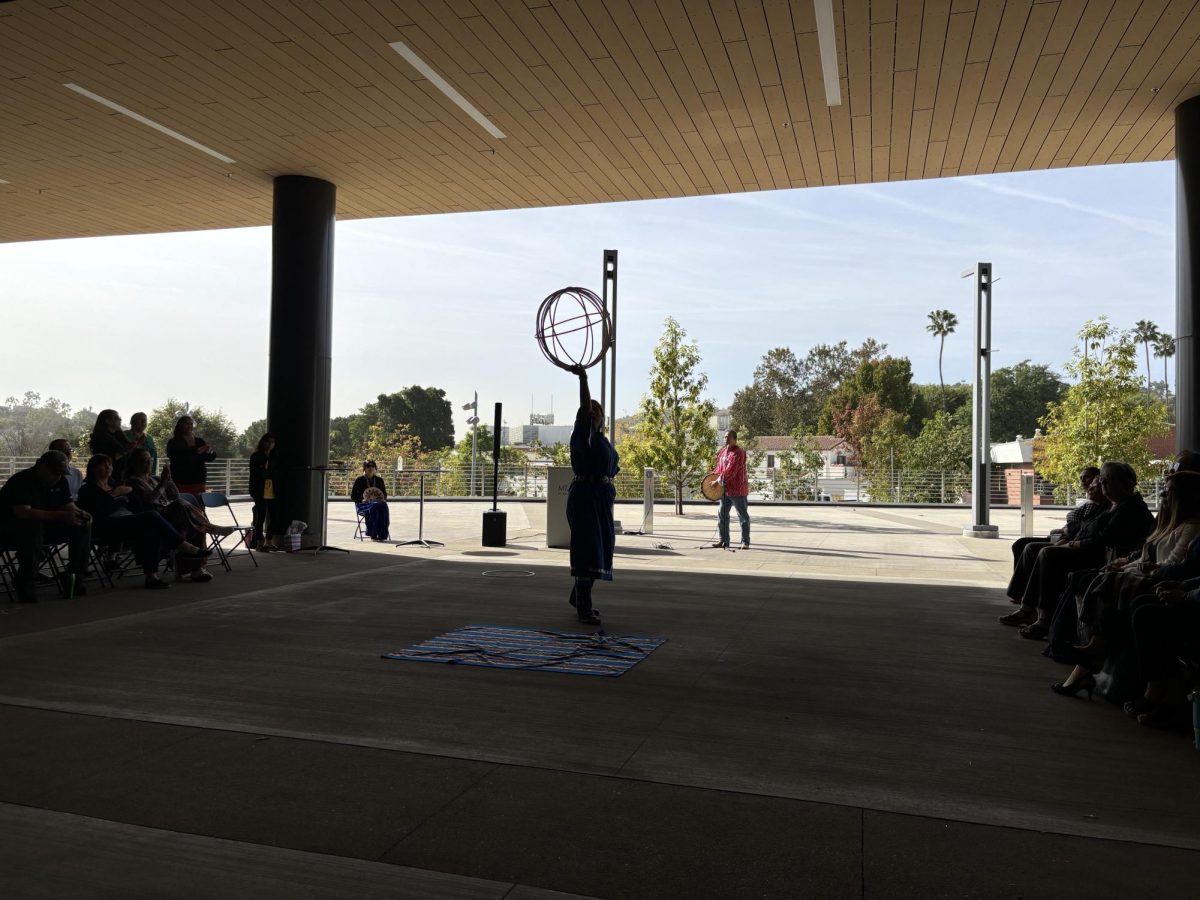A ceremony for balance
The smell of burning sage fills the Mt. SAC Student Center as the sacred hoop dance passed down through generations in the Navajo tribe begins. Warm sunlight streams into the Multicultural Center as the crowd awaits the Whipple family. The solitary beat of a drum resounds, drawing everyone’s attention to a young girl in a blue dress.

The talented Tahnaban Whipple starts her dance, moving around a blue rug placed in the center of the crowd. One by one she picks up rings forming an intricate shape of 11 rings around her body. This song and dance is meant to symbolize the creation of the universe,” says her father.
At the dance’s end, Tahnabah lifts a sphere crafted from 10 of the 11 rings into the air and her father concludes the song. The crowd applauds, captivated by this rare sight.
“This is the first-ever Native American and Indigenous Heritage Month opening ceremony at Mt. SAC,” associate Dean of student equity Eric Lara said.
On Nov. 6 the Whipple family was proud to begin Native American and Indigenous History Month, NAIHM, on campus, by preserving the spirit of the Navajo people. Mt. SAC’s president Marth Garcia acknowledged that with the election season, emotions are high and people are divided. Events like these bring hope to students and more specifically those who are American Indian or Alaskan Native whose traditions and culture have been eroded by today’s fast moving-world.
Honoring the ancestors
According to Frances Borella, Native American people have been walking “The Red Road” for centuries and understand the importance of having an elder to speak to. Borella began her speech by sharing that she only knows what was passed on to her and that this wisdom is now being referred to as “indigenous ways of knowing.”
Borella, an anthropology professor at Mt. SAC, is considered by many to be an elder on campus. She holds bachelor’s degrees in anthropology and geography, as well as a masters and a Ph.D. in anthropology.

Before the ceremony, Borella taught two classes. She mentioned in her speech that, “a lot of my students feel broken today.” Many young adults at Mt. SAC are uncertain about the nation’s future and feel unsure about who to turn to during this period of change. Recalling the advice of her elders, Borella said that “we must find balance on the road” despite the challenge of making “difficult decisions.”
“I was taught that a twig can break easily, but when we have a bundle of twigs and bind them together it can not be broken,” Borella said.
Following the ceremony, Mt. SAC hosted a Dia De Los Muertos, (“Miccailhuit”,event) for all Indigenous students who honor their ancestors that resided in present day Mexico.
The First People’s Native Center, made this possible through a partnership with the Bridge Program and El Centro. The event featured live music, food, and “ofrendas”, or offerings for deceased family members and friends of students.
Mt. SAC recognizes that many Indigenous students feel isolated by not having the opportunity to express their culture as opposed to the rest of their classmates. According to Lara, four years ago, it was brought to the Student Equity Committee’s attention that they had roughly 45 students registered as American Indian or Alaskan Native. Furthermore, Native American student enrollment had fallen 50% across all California community colleges during the past 10 years.
“Through the support of the student equity funds and the chancellor’s office funding through Native American grants, two years ago we opened the doors to the first ever First Peoples Native Center” Lara said. The associate dean of student equity noted that this center has been crucial for organizing events like “Miccailhuitl” which took place on Nov. 7.
Continuing on “The Read Road”
On Nov. 8 Native American Intertribal Student Alliance, collaborated with FPNC to host the “I am 1st Gen Native Alumni Panel.” This event featured three Native American panelists, offering insights to students on navigating the university system.
Panelist Randy Degroat, who was born in the Navajo Nation, studied at New Mexico State University, earning a bachelor’s degree in chemical engineering. He recalled that his freshman year was challenging but found his path by holding on to his dream of working with robots.
“People go at their own pace; take your time and find your community,” Degroat said.
As a Blackfoot Cherokee, Shaq Ransom agreed with Degroat on the importance of finding a mentor on campus. A former Mt. SAC student, Ransom initially struggled with adjusting to college life. He is originally from Brooklyn, New York, and began his studies here at age 20.
Now an anthropology major at Cal Poly Pomona, Ransom speaks 33 languages and has been with NAISA since April 13, 2018. As a blind man he also struggled because not all teachers would help with his disability, yet, despite these “barriers,” Ransom is set to graduate in 2027.
“All of you’ze guys better sign up for Dr. B’s class,” Ransom said.
Panelist Marissa Martinez, like Borella, returned to school as a parent. Although she lacked family support, NAISA supported her from day one.
Martinez stressed the importance of knowing “what services you like, what you don’t like, and what interests you because once you get to the university, it’s a whole different ball game.”
Navigating the college system is a unique challenge for Native American and Indigenous students, who often lack older siblings or relatives to guide them. “Less than 1% of all Native American students will ever receive a bachelor’s degree,” said Director of FPNC Primavera Reza-Nakonechny.
The more colleges use their resources to encourage education and cultural events the better it is for their students to feel represented and motivated to continue on their journey. Using the FPNC website, students can observe the 16 events taking place this month.
Throughout the month of November Borella leaves all students and staff asking, “Are you about hurting or healing, will you choose to love mother earth, and will you become part of our bundle?”


